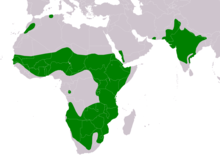
Back Roofarend AF عقاب لموع Arabic عقاب اصحم ARZ Aquila rapax AST Bozqır qartalı AZ Блед орел Bulgarian Bɔn BM তামাটে ঈগল Bengali/Bangla Àguila rapaç Catalan Aquila rapax CEB
| Tawny eagle | |
|---|---|

| |
| From Etosha National Park | |
| Scientific classification | |
| Domain: | Eukaryota |
| Kingdom: | Animalia |
| Phylum: | Chordata |
| Class: | Aves |
| Order: | Accipitriformes |
| Family: | Accipitridae |
| Genus: | Aquila |
| Species: | A. rapax
|
| Binomial name | |
| Aquila rapax (Temminck, 1828)
| |
| Subspecies[2] | |
| |

| |
| Range of A. rapax Resident
| |
| Synonyms | |
|
Aquila rapax rapax | |
The tawny eagle (Aquila rapax) is a large bird of prey. Like all eagles, it belongs to the family Accipitridae. Its heavily feathered legs mark it as a member of the subfamily Aquilinae, also known as booted eagles.[3] Tawny eagles have an extensive but discontinuous breeding range that constitutes much of the African continent as well as the Indian subcontinent, with rare residency in the southern Middle East.[4] Throughout its range, it favours open dry habitats such as semideserts, deserts steppes, or savanna plains. Despite its preference for arid areas, the species seldom occurs in areas where trees are entirely absent.[5] It is a resident breeder which lays one to three eggs in a stick nest most commonly in the crown of a tree.[6] The tawny eagle is perhaps the most highly opportunistic of all Aquilinae, and often scavenges on carrion or engages in kleptoparasitism towards other carnivorous animals but is also a bold and active predator, often of relatively large and diverse prey.[7] It is estimated that tawny eagles can reach the age of 16 years old.[8] Nonetheless, precipitous declines have been detected throughout the tawny eagle's range. Numerous factors, particularly loss of nesting habitat due to logging and global warming, as well as persecution (largely via poisoning) and other anthropogenic mortality (largely through contact with various manmade objects) are driving the once numerous tawny eagle perhaps to the brink of extinction.[1][8][9]
- ^ a b BirdLife International (2018). "Aquila rapax". IUCN Red List of Threatened Species. 2018: e.T22696033A131671001. doi:10.2305/IUCN.UK.2018-2.RLTS.T22696033A131671001.en. Retrieved 12 November 2021.
- ^ Gill F, D Donsker & P Rasmussen (Eds). 2020. IOC World Bird List (v10.2). doi : 10.14344/IOC.ML.10.2.
- ^ Helbig, A. J., Kocum, A., Seibold, I., & Braun, M. J. (2005). A multi-gene phylogeny of aquiline eagles (Aves: Accipitriformes) reveals extensive paraphyly at the genus level. Molecular phylogenetics and evolution, 35(1), 147-164.
- ^ Ferguson-Lees, J.; Christie, D. (2001). Raptors of the World. Houghton Mifflin Harcourt. ISBN 0-618-12762-3.
- ^ Hustler, K., & Howells, W. W. (1989). Habitat preference, breeding success and the effect of primary productivity on Tawny Eagles Aquila rapax in the tropics. Ibis, 131(1), 33-40.
- ^ Naoroji, R., & Schmitt, N. J. (2007). Birds of prey of the Indian subcontinent. Om Books International.
- ^ Brown, Leslie and Amadon, Dean (1986) Eagles, Hawks and Falcons of the World. The Wellfleet Press. ISBN 978-1555214722.
- ^ a b Wichmann, M.; Dean, W.; Jeltsch, F. (2004). "Global change challenges the Tawny Eagle (Aquila rapax): Modelling extinction risk with respect to predicted climate and land-use changes". Ostrich. 75 (4): 204–210. Bibcode:2004Ostri..75..204W. doi:10.2989/00306520409485446. S2CID 85057659.
- ^ Ogada, D. L. (2014). The power of poison: pesticide poisoning of Africa's wildlife. Annals of the New York Academy of Sciences, 1322(1), 1-20.
